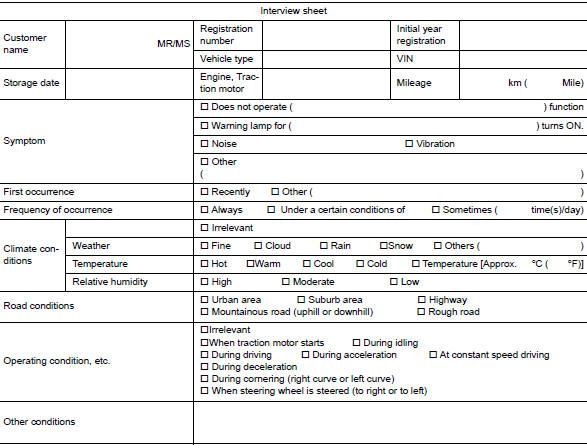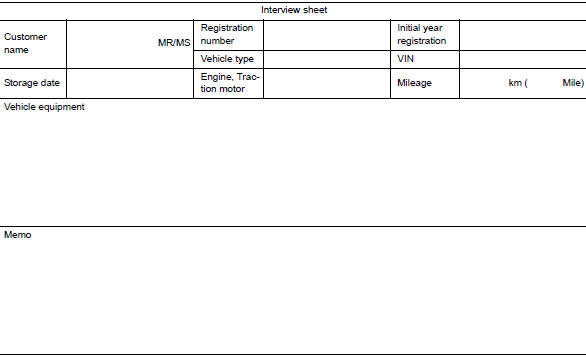Nissan Rogue Service Manual: Basic inspection
DIAGNOSIS AND REPAIR WORK FLOW
Work Flow
DETAILED FLOW
1.INTERVIEW FROM THE CUSTOMER
Clarify customer complaints before inspection. First of all, perform an interview utilizing DAS-202, "Diagnostic Work Sheet" and reproduce the symptom as well as fully understand it. Ask customer about his/her complaints carefully. Check symptoms by driving vehicle with customer, if necessary.
CAUTION: Customers are not professional. Never guess easily like ÔÇťmaybe the customer means that...,ÔÇŁ or ÔÇťmaybe the customer mentions this symptomÔÇŁ.
>> GO TO 2.
2.CHECK SYMPTOM
Reproduce the symptom that is indicated by the customer, based on the information from the customer obtained by the interview. Also check that the symptom is not caused by fail-safe mode. Refer to DAS-191, "Fail-Safe (Chassis Control Module)".
CAUTION: When the symptom is caused by normal operation, fully inspect each portion and obtain the understanding of customer that the symptom is not caused by a malfunction. >> GO TO 3.
3.PERFORM SELF-DIAGNOSIS
 With CONSULT
With CONSULT
- Perform ÔÇťSelf Diagnostic ResultÔÇť for ÔÇťCHASSIS CONTROLÔÇť.
Is DTC detected? YES >> Record or print self-diagnosis results and freeze frame data (FFD). GO TO 4.
NO >> Inspection End.
4.RECHECK THE SYMPTOM
 With CONSULT
With CONSULT
Perform DTC confirmation procedures for the malfunctioning system.
NOTE: If some DTCs are detected at the some time, determine the order for performing the diagnosis based on DAS- 193, "DTC Inspection Priority Chart". Is DTC detected? YES >> GO TO 5.
NO >> Check harness and connectors based on the information obtained by the interview. Refer to DAS- 171, "Precautions for Harness Repair".
5.REPAIR OR REPLACE MALFUNCTIONING PARTS
- Repair or replace malfunctioning parts.
- Reconnect part or connector after repairing or replacing.
- When DTC is detected, erase ÔÇťSelf Diagnostic ResultÔÇť for ÔÇťCHASSIS CONTROLÔÇŁ.
>> GO TO 6.
6.FINAL CHECK
 With CONSULT
With CONSULT
- Check the reference value for ÔÇťCHASSIS CONTROLÔÇŁ.
- Recheck the symptom and check that the symptom is not reproduced on the same conditions.
Is the symptom reproduced? YES >> GO TO 3.
NO >> Inspection End.
Diagnostic Work Sheet
Description
- In general, customers have their own criteria for a symptom. Therefore, it is important to understand the symptom and status well enough by interviewing the customer about the symptom carefully. To systemize all the information for the diagnosis, prepare the interview sheet referring to the interview points.
- In some cases, multiple conditions that appear simultaneously may cause a DTC to be detected.
INTERVIEW SHEET SAMPLE


ADDITIONAL SERVICE WHEN REPLACING CHASSIS CONTROL MODULE
Description
When replaced the chassis control module, configuration of the chassis control module is required. Refer to DAS-205, "Work Procedure".
CONFIGURATION (CHASSIS CONTROL MODULE)
Work Procedure
CAUTION:
- Use ÔÇťManual ConfigurationÔÇŁ only when ÔÇťTYPE IDÔÇŁ of the chassis control module cannot be read.
- After configuration, turn the ignition switch from OFF to ON and check that the chassis control warning to information display of combination meter displays OFF after staying illuminated for approximately two seconds.
- If an error occurs during configuration, start over from the beginning.
1.CHECKING TYPE ID (1)
Use FAST (service parts catalogue) to search the chassis control module of the applicable vehicle and find ÔÇťType IDÔÇŁ.
Is ÔÇťType IDÔÇŁ displayed? YES >> Print out ÔÇťType IDÔÇŁ and GO TO 2.
NO >> ÔÇťConfigurationÔÇŁ is not required for the chassis control module. Replace in the usual manner. Refer to DAS-277, "Removal and Installation".
2.CHECKING TYPE ID (2)
 CONSULT Configuration
CONSULT Configuration
- Select ÔÇťBefore Replace ECUÔÇŁ of ÔÇťRead/Write ConfigurationÔÇŁ.
- Check that ÔÇťType IDÔÇŁ is displayed on the CONSULT screen.
Is ÔÇťType IDÔÇŁ displayed? YES >> GO TO 3.
NO >> GO TO 7.
3.VERIFYING TYPE ID (1)
 CONSULT Configuration
CONSULT Configuration
Compare a ÔÇťType IDÔÇŁ displayed on the CONSULT screen with the one searched by using FAST (service parts catalogue) to check that these ÔÇťType IDÔÇŁ agree with each other.
NOTE: For the ÔÇťType IDÔÇŁ searched by using FAST (service parts catalog), use the last five digits of the ÔÇťType IDÔÇŁ.
>> GO TO 4.
4.SAVING TYPE ID
 CONSULT Configuration
CONSULT Configuration
Save ÔÇťType IDÔÇŁ on CONSULT.
>> GO TO 5.
5.REPLACING CHASSIS CONTROL MODULE (1)
Replace the chassis control module. Refer to DAS-277, "Removal and Installation".
>> GO TO 6.
6.WRITING (AUTOMATIC WRITING)
 CONSULT Configuration
CONSULT Configuration
- Select ÔÇťAfter Replace ECUÔÇŁ of ÔÇťRe/programming, ConfigurationÔÇŁ or that of ÔÇťRead / Write ConfigurationÔÇŁ.
- Select the ÔÇťType IDÔÇŁ agreeing with the one stored on CONSULT and the one searched by using FAST (service parts catalogue) to write the ÔÇťType IDÔÇŁ into the chassis control module.
NOTE: For the ÔÇťType IDÔÇŁ searched by using FAST (service parts catalog), use the last five digits of the ÔÇťType IDÔÇŁ.
>> GO TO 9.
7.REPLACING CHASSIS CONTROL MODULE (2)
Replace the chassis control module. Refer to DAS-277, "Removal and Installation".
>> GO TO 8.
8.WRITING (MANUAL WRITING)
 CONSULT Configuration
CONSULT Configuration
- Select ÔÇťManual ConfigurationÔÇŁ.
- Select the ÔÇťType IDÔÇŁ searched by using FAST (service parts catalogue) to write the ÔÇťType IDÔÇŁ into the chassis control module.
NOTE: For the ÔÇťType IDÔÇŁ searched by using FAST (service parts catalog), use the last five digits of the ÔÇťType IDÔÇŁ. >> GO TO 9.
9.VERIFYING TYPE ID (2)
Compare ÔÇťType IDÔÇŁ written into the chassis control module with the one searched by using FAST (service parts catalogue) to check that these ÔÇťType IDÔÇŁ agree with each other.
NOTE: For the ÔÇťType IDÔÇŁ searched by using FAST (service parts catalog), use the last five digits of the ÔÇťType IDÔÇŁ. >> GO TO 10.
10.CHECKING CHASSIS CONTROL WARNING
- Turn the ignition switch OFF.
- Turn the ignition switch ON and check that the chassis control warning to information display of combination meter displays OFF after staying illuminated for approximately two seconds.
CAUTION: Never start the engine. Is the inspection result normal? YES >> GO TO 11.
NO >> Perform the ÔÇťSelf Diagnostic ResultÔÇŁ of ÔÇťCHASSIS CONTROLÔÇŁ. Refer to DAS-182, "CONSULT Function".
11.PERFORMING SUPPLEMENTARY WORK
- Perform the self-diagnosis of all systems.
- Erase self-diagnosis results.
>> End of work.
 Wiring diagram
Wiring diagram
CHASSIS CONTROL
Wiring Diagram
...
 DTC/circuit diagnosis
DTC/circuit diagnosis
C1B92-00 BRAKE CONTROL SYSTEM
DTC Description
DTC DETECTION LOGIC
DTC
Display Item
(Trouble diagnosis content)
Malfunction detected condition
C1B92-00
BRAKE ...
Other materials:
Indicator lights
For additional information on warnings and indicators,
refer to ÔÇťVehicle information displayÔÇŁ in
this section.
All-Wheel Drive
(AWD) AUTO indicator light (if so equipped)
When the ignition switch is in the ÔÇťONÔÇŁ position,
the All-Wheel Drive (AWD) AUTO indicator light
illuminates.
...
Removal and installation
IPDM E/R (INTELLIGENT POWER DISTRIBUTION MODULE ENGINE
ROOM)
Exploded View
IPDM E/R cover
IPDM E/R
IPDM E/R case
IPDM E/R harness cover A
IPDM E/R harness cover B
Front
Removal and Installation
CAUTION: IPDM E/R integrated relays are not serviceable
parts, do not ...
FCW system operation
Forward Collision Warning light
The FCW system is active at speeds of approximately
10 MPH (15 km/h) and above, when the
system turns on.
When FCW is turned on, FCW Indicator (white)
will turn on. FCW system is activated using the
settings menu on the information display. For
additional ...
